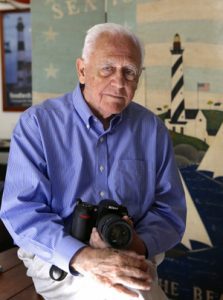
February 4, 1930 – June 16, 2023
Two withered old men playing checkers in front of a country store in a timeless town in the Appalachians, children playing in a park somewhere on the last joyous day of summer, the gyrating hips of a teenaged and not yet famous Elvis Presley, the glowing crystal lens of an Outer Banks lighthouse offering its guidance to those of us lost in the dark…these and many thousands of similar images provide the lens through which we must remember Bruce Roberts. Bruce died at a little after 3 o’clock in the afternoon on Friday, June 16th of that most natural of causes, the passage of time—he was 93—and with his passing we have lost one of America’s greatest photographic chroniclers.
Bruce often said that among his most potent early memories was attending a 1940 presidential campaign rally for Wendell Willkie, an oddity since Willkie was a Republican and Bruce would prove a lifelong Roosevelt-style Democrat. In fact, politics never ranked high among Bruce’s passions. Places did, though, along with the people, history, and nature that splashed them with color and meaning. These were the instincts that would, in time, make Bruce the ultimate travel photographer, but he got his start as and remained throughout his life a photojournalist.
In 1954, having graduated from New York University and spent two years in the Air Force achieving staff sergeant, Bruce received an offer of work as a newspaper photographer from the News-Messenger, a weekly in tiny Hamlet, North Carolina. They could pay only $70 a week and the darkroom had no air conditioning, but he jumped at the chance to work in North Carolina. He had recently seen a feature on the American South in National Geographic and its depictions of North Carolina’s spectacular mountains, coasts, and islands intrigued him. This seemed the perfect backdrop for the stories he wanted to tell with his camera.
The young photographer’s enthusiasm showed through as the News-Messenger soon began to receive regional and even national awards for its photographs, honors rarely handed out to weekly newspapers. These successes inevitably caught the attention of Pete McKnight, legendary editor of the Charlotte Observer, who was determined to assemble a world-class staff. Hired by McKnight, Bruce became part of a highly talented Observer team which, during the 1960s, pioneered the use of the 35-mm camera and natural light for newspaper photography. Bruce saw this as the truest and most direct way to tell a story with candid, unposed pictures.
Years later, he would bring the same approach to Southern Living Magazine where he served for more than a decade as Director of Photography and Senior Photographer. Having worked for or contributed voluminously to Southern Living during its formative years, Bruce is credited by many with giving this quintessentially Southern publication its distinctive appearance.
Over the years, Bruce contributed to many national publications including Time, Life, Sports Illustrated, and Time-Life Books to name just a few. His photography appeared in numerous books including Where Time Stood Still: A Portrait of Appalachia, picked by the New York Times as one of the best children’s books of the 1970s, The Face of North Carolina, and You Can’t Kill the Dream. He also researched and authored the first book on The North Carolina Goldrush. His photos appeared often from its initiation in Our State magazine, and his passion to represent the disgrace of segregation was recognized and featured in I Am a Man exhibition sponsored by the National Endowment of the Arts that started in Montpellier, France, in 2020, came to Chapel Hill, NC in January 2021, and is still traveling the world.
However, Bruce is surely best remembered for his lighthouse photography. He authored or coauthored literally dozens of books on America’s coastal sentinels. Together with his multitalented wife, historian and author Cheryl Shelton-Roberts, and writer and publisher Ray Jones, a close friend for over forty years, he helped launch the lighthouse movement of the 1990s and early 2000s which led to the preservation of many of America’s most historic lighthouses. Bruce and Cheryl co-founded the Outer Banks Lighthouse Society which was partly responsible for saving the eminently historic Cape Hatteras Lighthouse. Because of his lighthouse publications and preservation work, Bruce was honored as a “Keeper of the Light” by the American Lighthouse Foundation.
Many of Bruce’s photos have been collected by the U.S. National Archives and the Library of Congress. Large portions of his photographic legacy are held by the University of Texas (Austin), Photo Researchers/Science Source (New York), and other historical repositories. Together, these images represent a profoundly humane and optimistic expression of what it means to be an American.
Bruce is survived by his wife of 33 years, Cheryl Shelton-Roberts, daughters Courtney and Nancy (Fred), son David, a grandson, and nieces Pam (Bob) and Leslie (Stan). He is preceded in death by his father and mother, Charles Wesley and Marion Roberts, and sister Laurene.
A special thank you to Crystal Coast Hospice, Newport, NC, for its compassionate and professional help to Bruce during his last earthly journey. And thank you to Ray Jones for writing this beautiful tribute to his dear friend and colleague.
A Celebration of Bruce’s life will be held at a later date.



